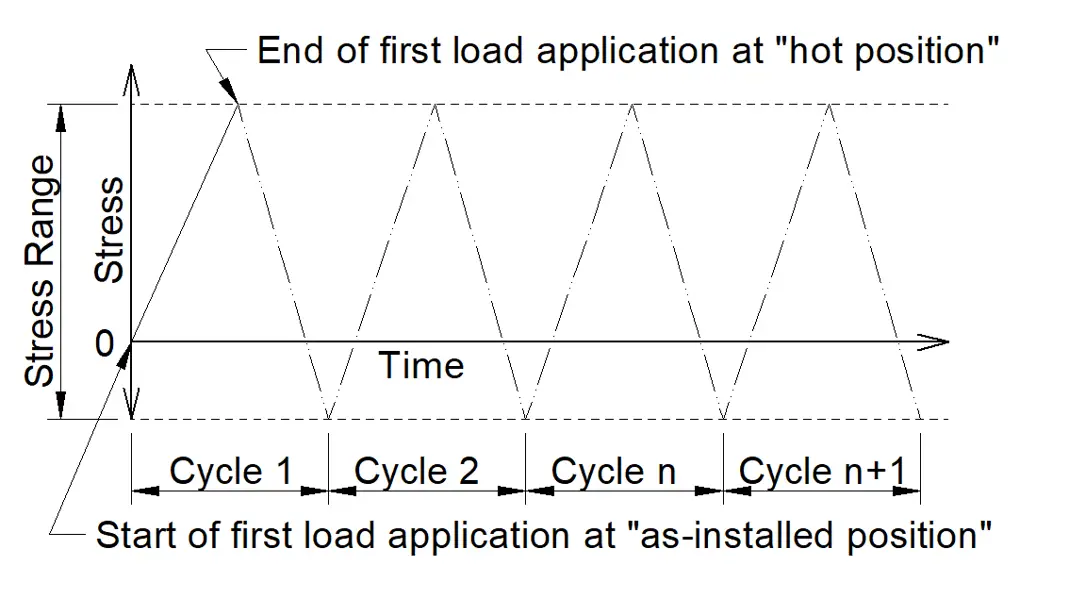Pressure drop is a widely used term that is frequently used in design engineering, process industries, etc. So it is very important to have a thorough knowledge of pressure drop. Pressure drop is the difference in pressure between two points provided that there is a fluid flow between those points. So pressure drop occurs when a fluid (gas/liquid) material enters one point of the piping system and exits through the other points. In that case, process piping systems should have losses of pressure, and this phenomenon is known as pressure drop.
Pressure drop occurs due to friction caused by fluids rubbing against the pipe surface and the internal walls of a pipeline.
For a system, pressure drop can be calculated with engineering equations that require the type of fluid, flow rate, fluid properties, plot plan, and piping material specifications (including thickness, schedule number, and pipe diameter).
Why does Pressure Drop important?
If the pressure drop in a system is high then the process fluid temperature rises, and energy consumption will be high. Overall system pressure also increases for the high-pressure drop. The high-pressure drop also increases wear on components and causes potentially dangerous & over-pressure scenarios. Lastly, a large pressure drop may render some piping component systems disable due to insufficient operating pressure.
Process engineers should have a clear understanding of the pressure drop of the whole network associated with a fluid to be handled so that they can determine the size, capacity of the pump and motors, and piping diameter required to carry the specific fluid through the piping system.
The larger the pressure drops in the pipeline, the larger the energy required to retain the required process flow, requiring a higher horsepower motor. On the other hand, for low, pressure drop in a pipeline, less energy is required, providing the potential to use a smaller hp motor. Pressure drop also governs the overall pressure of the system or head requirements.
What is a Pressure Head?
In short, the pressure head is defined as the height (m/ft) to which a selected pump can bring a column of water that is usually expressed in meters.
It is the magnitude of the force the pump exerts on the fluid that is being pumped. From the Pump vendor, data pressure heads may be available or they can be calculated from the formula.
What factors affect the Pressure Drop?
The following factors affect the pressure drop in a fluid-carrying network,
Fluid Component
Various fluid parameters like Density, Heat capacity, Temperature, and Viscosity affect the pressure drop of the fluid.
Some products change their viscosity drastically while being pumped through a pipeline due to shear. These kinds of products will become due to frictional effects caused by the passing through the pumps and the internal surfaces of the pipes. This type of fluid is called the thixotropic fluid which is a time-dependent fluid. Thixotropic fluids are usually viscous fluids in stagnant conditions. But it gets thinner or low viscous during movement while shaking or mixing & it returns to its normal state while the means of mixing is removed.
On the other hand, some others are called Newtonian fluids under certain processing conditions. Newtonian fluids are not thixotropic fluid, and it is not subjected to vary their viscosities upon exposure to shear force. Fluids that show Newtonian characteristics may add to higher pressure drop while being pumped through a piping system because their viscosity will not vary as it passes through the system.
Mechanical Component
The mechanical elements in a piping system that imparts pressure drops are valves, strainers, flow meters, couplings, fittings, bends, and tubing. Excluding pumps, all of these other elements commonly available in a process piping system contribute to an overall pressure drop of the system as they remove pressure energy from the process fluid, rather than adding to it.
This dynamic pressure drop depends on the cross-sectional area of the piping system as well as an internal surface roughness (roughness factor), the equivalent length of the pipeline.
Changes in Elevation
Changes in elevation in the Piping system significantly affect the pressure drop. The additional pressure drop will occur if the starting elevation of a pipe is lower than its end elevation. This elevation difference is measured in the fluid industry in terms of the fluid head.
For a general piping system, the overall pressure drop is usually calculated using equations similar to the following:
P(end)= P(start) – friction loss- fittings loss -component loss + elevation (start-end) + pump head
Pressure Drop Equations/ Pressure Drop Calculation
Due to different elevations, turbulence caused by changes in flow direction and frictional losses while flowing through piping and losses due to fittings pressure drop or head loss is caused. The widely used methods used to calculate the head loss in glass pipe are Manning, Darcy-Weisbach, and Hazen-Williams, equations. The applicability of each method governs by the flow pattern (gravity flow or pumped flow).
Hazen-Williams Equation
The Hazen-Williams equation is normally used for water pipes while the flow is fully turbulent flow. It has achieved a wide range of acceptance in the water and wastewater industries as it is very simple to use. The equation is as follows,
V=0.85 C R0.63 J0.54
where
- v = velocity, m/s
- C = Hazen-Williams Coefficient
- R = Hydraulic mean radius, m
- J = Hydraulic gradient, m/m
- Hazen-William coefficient, C for ADPF fiberglass pipe is taken as 150.
Manning Equation
For gravity difference flow, the Manning equation typically is used to solve gravity flow problems where the flow partially fills the pipe under the influence of changes in elevation.
The equation is as follows,
V= (1/n) R0.667J0.5
where
- v = velocity, m/s
- n = Manning’s Coefficient
- R = Hydraulic mean radius, m
- J = Hydraulic gradient, m/m
- Manning’s Coefficient, n for ADPF fiberglass pipe is taken as 0.01.
Darcy-Weisbach Equation
This equation states that pressure drop is directly proportional to the square of the velocity and the length of the pipe. This equation is applicable for all fluids for both laminar as well as turbulent flow. The disadvantage of this equation is that the Darcy-Weisbach friction factor is a variable that can be found in the standard chart available. The equation is as follows,
J= (fLV2)/2gD
where
- J = Head loss, m
- g = Gravity constant, 9.81 m/s²
- v = Velocity, m/s
- D = Inside diameter, m
- f = Friction factor
- L = Length of the pipe, m
Types of Fluid Flow
The well-known Reynolds number equation is used to characterize the fluid flow.
Re = v.D / ν
where ν= Kinematic viscosity, m²/s
The table given below determines the type of flow of fluid from the Reynolds number.
| Type of Flow | Reynolds Number |
| Laminar Flow | Re≤2200 |
| Transition Flow Zone | 2200≤Re≤4000 |
| Turbulent Flow | Re≥4000 |
If the flow is Laminar, f = 64 / Re
If the flow is Turbulent, the friction factor can be determined from the Moody diagram found in most fluid mechanics texts or calculated from the Colebrook equation.
1/√f=-2Log(ε/3.71D+2.51/(Re√f))
where
- ε = Roughness.
- Re = Reynolds number
The Colebrook correlation friction factor for fiberglass pipe is determined as 0.04 mm which includes the head losses over joints.
Pressure drops in Pipe Fittings
Head Loss or pressure drop in Pipe fitting is usually defined as the equivalent length of pipe that is added to the straight run of pipe. This approach is mostly associated with the Hazen-Williams or Manning’s equations. This method does not consider the effect due to turbulence and subsequent losses caused by different velocities.
Equivalent Length (in m)
| Pipe Fittings | 150 | 200 | 250 | 300 | 350 | 400 | 450 | 500 | 600 | 700 | 800 | 900 | 1000 |
| 90ᵒElbow | 8.5 | 6.4 | 7.9 | 9.4 | 10.7 | 12.2 | 14.0 | 17.0 | 23.0 | 28.0 | 32.4 | 37.1 | 42.3 |
| 45ᵒElbow | 3.5 | 3.4 | 4.2 | 5.0 | 5.7 | 6.5 | 8.2 | 10.9 | 13.6 | 16.2 | 20.1 | 23.5 | 25.6 |
| Tee | 11.0 | 14.4 | 17.8 | 21.1 | 24.0 | 27.5 | 32.8 | 38.3 | 49.5 | 61.5 | 72.9 | 84.6 | 96.8 |
For a more accurate calculation, head loss in fittings can be determined using loss coefficients (K-factor) for each type of bend & fittings. In this method, K-factor is multiplied by the velocity head of the fluid flowing through the bends and fittings.
The relevant equation is H=K x (V2/2g).
where,
- H = Head loss, m
- V = Velocity of flow, m/s
K-Factors for Pipe Fittings
| Type of Pipe fittings | K-Factor |
| 90ᵒElbow, standard | 0.5 |
| 90ᵒElbow, single miter | 1.4 |
| 90ᵒElbow, double miter | 0.8 |
| 90ᵒElbow, triple miter | 0.8 |
| 45ᵒElbow, standard | 0.3 |
| 45ᵒElbow, single miter | 0.5 |
| Tee, flow to branch | 1.4 |
| Tee, flow from branch | 1.7 |
| Reducer, single reduction | 0.7 |
Water Hammer
It is caused due to pressure surge or internal shock, resulting from a sudden change of velocity within the system. As a result, these shock waves can reach a sufficient level to rupture or collapse a piping system irrespective of the material of construction. The surge pressure is the faster moving wave that increases as well as decreases the pressure in the piping system that depends on the source of the direction of the shock wave travels. Fast valve closure can result in the building-up of shock waves as the kinetic energy of the faster-moving fluid is converted to the potential energy that must be accommodated. These pressure waves traverse throughout the whole piping system and may cause mechanical damage far away from the source of the shock wave.
The effect of the water hammer depends on,
- Physical properties of the fluid
- Volumetric flow rate
- Elastic modulus of the pipe material
- The equivalent length of the pipeline
- Rate of change of momentum
The lower value of elastic modulus fiberglass generates a dampening effect as the pressure wave moves along the piping system. As the elastic modulus of piping material is very high so the pressure waves generated in the pipeline are very high in magnitude. Additionally, due to the fast closure and opening of the valve, sudden air release, and start-up or shut down of the pump can cause water hammer.
Talbot formula gives:
P= (a.w.V)/(144.g)=(a/g).(SG/2.3).V
where,
- a=Wave velocity (ft/s)
- P = Surge Pressure (psi)
- v = fluid velocity (ft/s)
- w = Density of fluid (lb/ft³)
- SG = Specific gravity of the fluid
- K = Bulk modulus of fluid (psi)
- E = Hoop modulus of elasticity (psi)
- d = Inside diameter of the pipe (inch)
- t = Pipe wall thickness (inch)
- g = Acceleration due to gravity (ft/s²)
How to prevent water hammer?
Standard design practices can avoid water hammers in most systems.
- Rapid opening and closing of valves are to be avoided.
- Avoid starting pumps into empty discharge lines unless mechanically actuated valves gradually open.
- NRV or check valves on pumps should be closed as fast as possible to reduce the velocity of fluid flowing back.
- Proper anchoring of the piping system can stop this problem.
- Accumulators, and feedback control loops around pumps can be implemented to prevent occurring of water hammers.









Excellent
Thank you very much for your explanation of pressure drop knowledge and calculation method.
This was really helpful thanks alot 🙌🧡🧡❤️